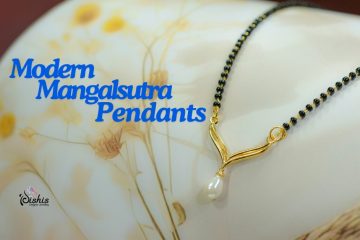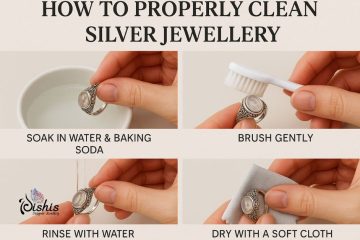Have you ever wondered how to differentiate between an original gold or a diamond and an imitation? Regardless of whether you’re shopping online at a jewelry store, considering an investment or a gift, you cannot afford to buy a piece of jewellery that is fake. Today let’s discuss the real gold and diamonds and get to know which one is better.
How to Spot Real Gold?
The higher the figure the higher the carat age of the gold. However, if the piece does not display a hallmark then it could be a forgery some websites sell this ornamented piece of jewelry. If you can’t see the hallmark, you should always ask the seller for it.
-
Check the Hallmark or Stamp
Gold is non-magnetic and therefore if a magnet sticks to the jewelry then it contains no pure gold. This totally simple test reveals the fake ones. Retain a positive attraction and bring a very powerful magnet alongside the jewelry. If it is attracted into the magnet then this may contain yet another metal for instance iron or even steel therefore it is not genuine gold.
- 24K is pure gold, which means it has no other metals mixed in.
- 18K means the jewelry is 75% gold and 25% other metals.
- 14K is 58.3% gold.
- 10K is 41.7% gold.
The higher the number, the purer the gold. However, if there is no hallmark on the piece, it might be a sign that it’s fake. Always ask the seller for the hallmark if it’s not visible.
-
Conduct the Magnet Test
To perform the scratch test you don’t know if your gold is real or fake or not you simply scratch the metal against another metal. To make this electrostatics experiment, you’ll require unglazed ceramics, for example, a plate or tile. Find a piece of gold, and then rub it on the surface of the ceramics in a delicate motion. If it has a golden streak, then it’s most likely solid gold. This is probably why if the streak is black, then the metal is probably not gold.
-
Perform the Scratch Test
If you’re unsure whether your gold is authentic, you can try the scratch test. You’ll need a piece of unglazed ceramic. Take the piece of gold and gently scratch it across the surface of the ceramic. If it leaves a golden streak, it’s probably real gold. If the streak is black, the metal is likely not gold.
-
Use the Nitric Acid Test
This test is a professional standard among people. It includes a process of using one drop of nitric acid on the surface of the gold item. If gold appears to be green, then the piece is not composed of real gold, it can not be genuine gold. Pseudo gold will dissolve in this reagent since it is, in fact, copper pyrites that will dissolve in nitric acid while real gold will not. However, this test should be done carefully and may harm your jewelry, therefore, it is advisable that you seek help from a professional.
-
Weight and Density Test
Gold is a dense metal, meaning it is heavier than most metals of similar size. If you have a piece of gold jewelry and you suspect it might be fake, you can compare its weight to its size. The piece should feel heavier than other metals of similar size. You can also use a scale and measure its density by dividing the mass of the object by its volume. Pure gold has a density of 19.3 grams per cubic centimeter.
How to Spot Real Diamonds?
Diamonds are another item that’s often faked or imitated. While there are many ways to tell if a diamond is real or fake, most require the use of special tools. However, there are a few simple methods you can use to check a diamond’s authenticity.
-
The Fog Test
Diamonds are excellent at dispersing heat. To check if your diamond is real, breathe on it, and observe how it reacts. If it fogs up and takes a few seconds to clear, it’s probably a fake diamond. Real diamonds do not fog up easily because they don’t hold onto moisture. The fog will disappear almost instantly if the stone is real.
-
The Water Test
This test operates based on the fact that the diamond has a high density accompanied with a relatively heavy weight. Take a glass and pour water into it and then drop the diamond into this glass of water. Real diamonds are very much denser and will quickly settle to the bottom of the glass. Diamonds or those made from plastic or glass will prove to be lighter than the genuine diamond and will not submerge in the glass of water.
-
Check for Sharp Edges
Real diamonds have sharp edges, and you should be able to feel them if you run your finger around the stone. Fake diamonds mostly consist of rounded edges because they are not made of diamond but glass and cubic zirconia. A magnifying glass or jeweler’s loupe to inspect the edges closely.
-
The Sparkle Test
Real diamonds sparkle in a way that imitators can’t replicate. Diamonds reflect light in two ways: they shine with a white, brilliant sparkle (called “brilliance”), and they also show flashes of color (called “fire”). Hold the diamond under a bright light and see if it sparkles in these two ways. If it only shines with a white sparkle and no color flashes, it might not be a real diamond.
-
Use a Loupe
A jeweler’s loupe is a magnifying glass used to closely examine diamonds. When you look at a real diamond through a loupe, you may see small imperfections or inclusions inside the stone. These are natural characteristics of diamonds, known as “blemishes” or “inclusions,” and they can help identify a genuine diamond. Fake diamonds, especially those made from materials like cubic zirconia, are usually flawless.
-
Look for a Certificate
If you’re buying a diamond from a reputable jeweler, ask for a certificate of authenticity. This certificate should come from a recognized laboratory, such as the Gemological Institute of America (GIA), and it will provide detailed information about the diamond’s quality, including its cut, color, clarity, and carat weight.
Conclusion
When buying gold or diamonds, one would expect that they are genuine, there are methods of ascertaining this. If you are in doubt whether you are dealing with the real gold, you can always check with a hallmark, give it a magnet test or even put it into an acid. Hence the fog test, water test, and sparkle test could just provide one with the relevant information whether the diamond is real or a fake one.
One is advised to follow the above mentioned easy instructions for better understanding in identifying genuine gold and diamonds to avoid falling prey with fake products. Remember what matters is the quality, spend some time taking and spot the gold and diamond when you are next purchasing it.



0 Comments